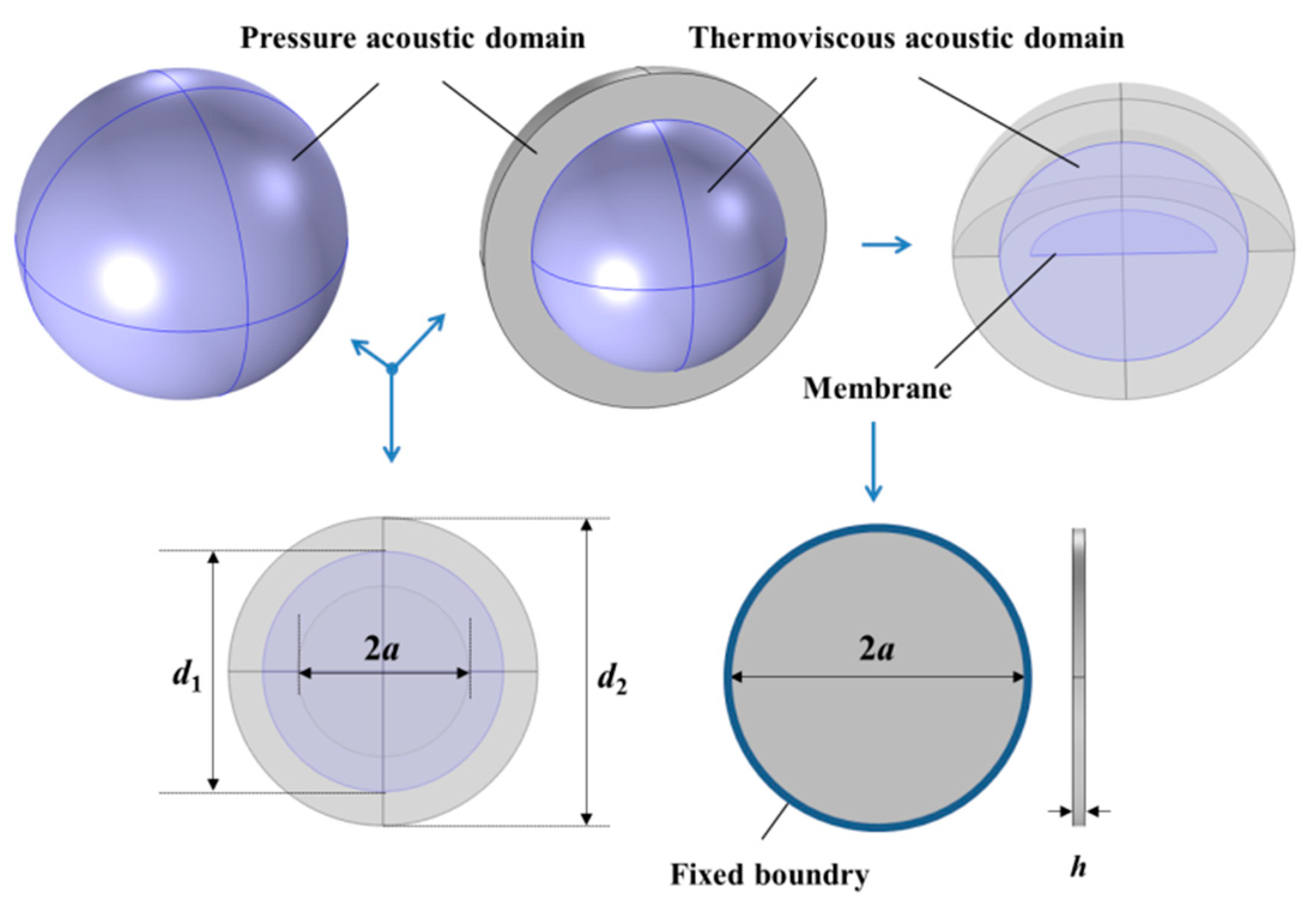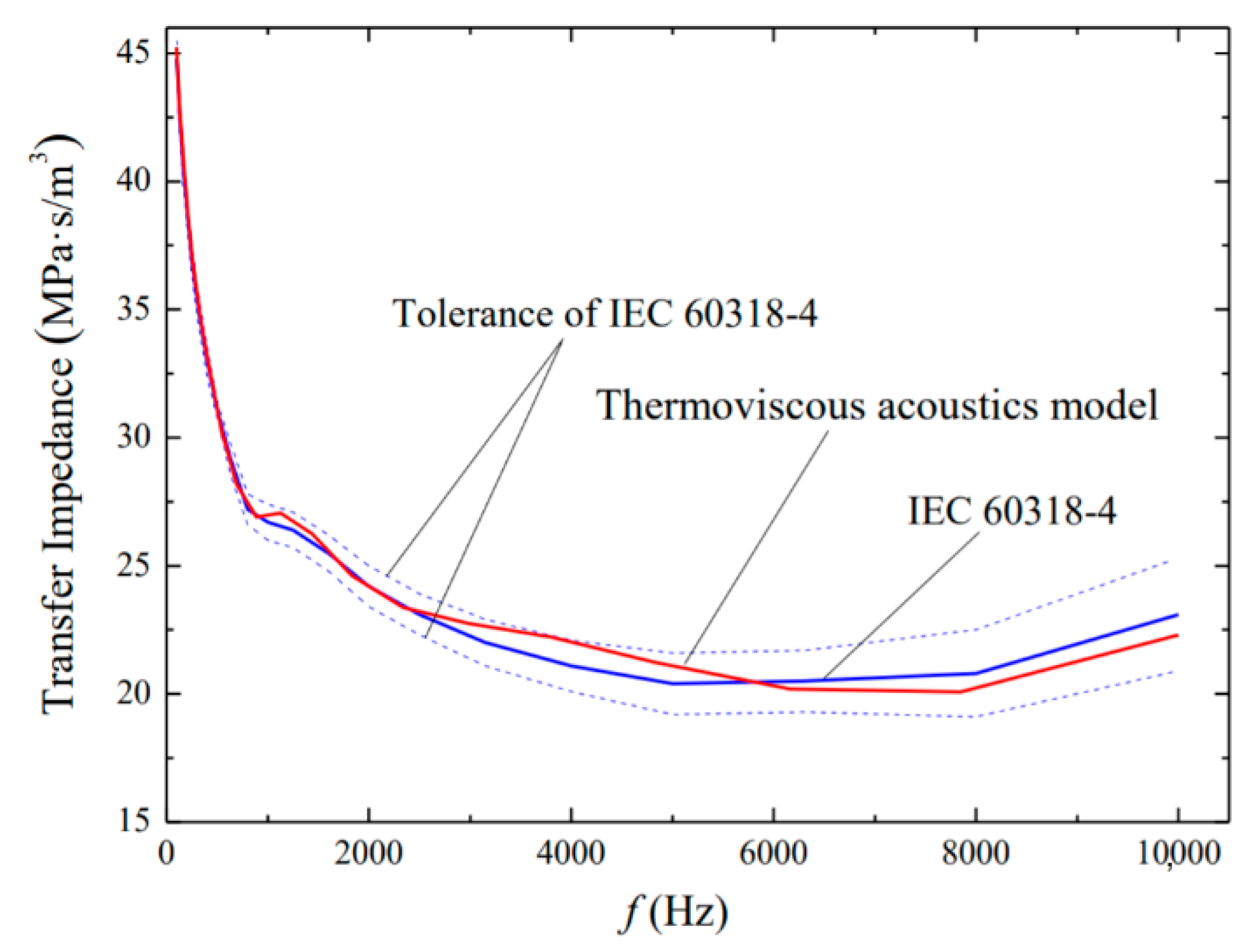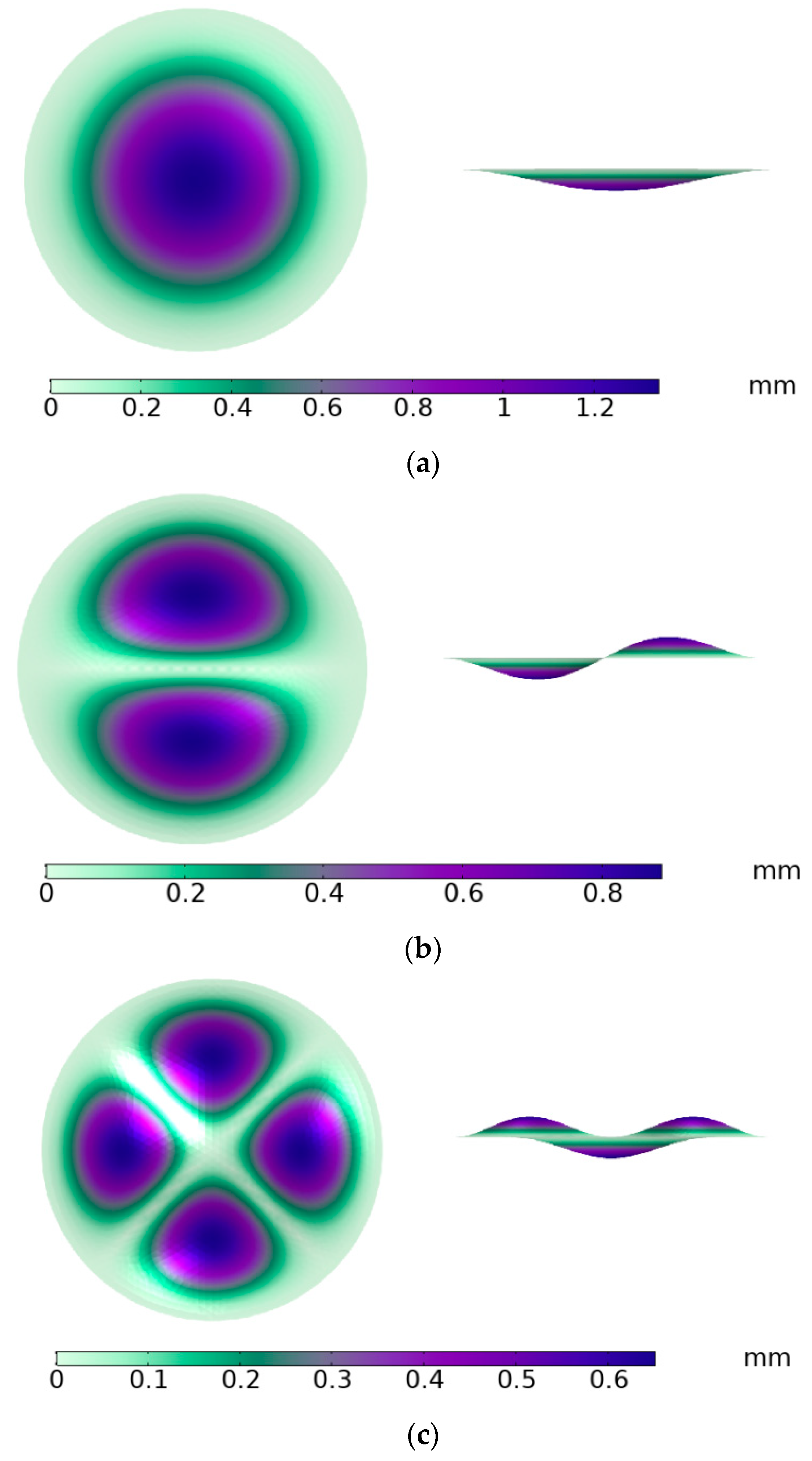Numerical Study of Vibration Characteristics for Sensor Membrane in Transformer Oil
Abstract
1. Introduction
2. Physical Model and Computational Method
2.1. Physical Model and Geometric Parameters
2.2. Governing Equations and Computational Methods
3. Model Validation and Grid Independence Test
3.1. Model Validations
3.2. Grid Independence Test
4. Results and Discussion
4.1. Natural Frequency Analysis
4.2. Amplitude-Frequency Characteristics
4.3. Time Domain Response
5. Conclusions
- For the first-order vibration mode, the membrane has the same phase point, which would be beneficial for prediction membrane vibration through the intensity of output light. As the membrane vibration mode order increases, the membrane vibration amplitude decreases gradually, and the membrane sensitivity should be the highest for the first-order vibration mode. The effect of transformer oil on the natural frequency of membrane vibration is remarkable, especially for the lower-order vibration modes. In the present study, the first-order natural frequency of membrane vibration is reduced by 60% in transformer oil.
- As the membrane vibrates, the oil velocity gradient near the surface of membrane is relatively large, which will lead to a viscous loss for membrane vibration, and its vibration amplitude is reduced to one-fifth of that for the non-viscous vibration. When the vibration frequency of the membrane is close to its natural frequency, the vibration amplitude of the membrane is larger, and the effect on the oil velocity field caused by the vibration is wider and more significant. As compared with oil velocity distributions around the membrane, the variations in oil temperature are relatively small as the vibration frequency changes.
- The effect of transformer oil viscosity on the time domain response of membrane vibration is remarkable. When the membrane vibrates in viscous oil, mechanical energy is converted into thermal energy during the vibration and its vibration amplitude will decrease gradually with time. Therefore, when we design the membrane, the effect of oil viscosity on the membrane vibration displacement attenuation should be considered.
Author Contributions
Funding
Data Availability Statement
Conflicts of Interest
Nomenclature
| a | The radius of membrane (m) |
| b0 | Second virial coefficient |
| c | The speed of sound transmission (m/s) |
| c0 | The coefficient related to the vibration mode |
| cp | Constant pressure heat capacity (J/kg·K) |
| Cs | Damping matrix |
| d1 | Diameter of thermoviscous acoustic domain (m) |
| d2 | Diameter of pressure acoustic domain (m) |
| E | Young’ s modulus (Pa) |
| f | Natural frequency (Hz) |
| Fp | The force caused by structure vibration (N) |
| FT | External load (N) |
| h | The thickness of membrane (m) |
| i | Imaginary number |
| I | Output light intensity (cd) |
| I0 | Input light intensity (cd) |
| k | Thermal conductivity (W/m·K) |
| Ks | Stiffness matrix |
| l | Cavity length (m) |
| Ms | Mass matrix |
| p | Pressure (Pa) |
| pmic | The average pressure at the eardrum (Pa) |
| Qin | The air volume flow rate (m3/s) |
| R1 | The fiber end face reflectivity |
| R2 | The membrane reflectivity |
| S | Sensitivity (Pa/m) |
| t | Time (s) |
| T | Temperature (K) |
| T0 | Average temperature (K) |
| Velocity (m/s) | |
| w(t) | Displacement of membrane vibration (m) |
| Velocity membrane vibration (m/s) | |
| Acceleration membrane vibration (m/s2) | |
| Y | The relative collision frequency |
| Ymax | The largest deformation (m) |
| Ztrans | Transfer impedance (MPa·s/m3) |
| Greek letters | |
| α0 | Thermal expansion coefficient (1/K) |
| η | Shear viscosity (Pa·s) |
| ηB | Bulk viscosity (Pa·s) |
| λ | Light wavelength (m) |
| μ | Poisson’s ratio |
| ρ | Transformer oil density (kg/m3) |
| ρ0 | Average transformer oil density (kg/m3) |
| ρM | Membrane density (kg/m3) |
| ω | Angular frequency (rad/s) |
| Abbreviations | |
| EFPI | Extrinsic Fabry-Perot interferometer |
| UHF | Ultra-high frequency detection method |
References
- Zdanowski, M. Streaming Electrification Phenomenon of Electrical Insulating Oils for Power Transformers. Energies 2020, 13, 3225. [Google Scholar] [CrossRef]
- Pardauil, A.C.N.; Nascimento, T.P.; Siqueira, M.R.S.; Bezerra, U.H.; Oliveira, W.D. Combined Approach using Cluster-ing-Random Forest to evaluate Partial Discharge Patterns in Hydro Generators. Energies 2020, 13, 5992. [Google Scholar] [CrossRef]
- Witos, F.; Olszewska, A.; Opilski, Z.; Lisowska-Lis, A.; Szerszeń, G. Application of Acoustic Emission and Thermal Imaging to Test Oil Power Transformers. Energies 2020, 13, 5955. [Google Scholar] [CrossRef]
- Park, S.; He, S. Standing wave brass-PZT square tubular ultrasonic motor. Ultrasonics 2012, 52, 880–889. [Google Scholar] [CrossRef]
- Xie, P.; Kang, J.; Li, Q.; Zhu, J.; Li, L. Finite element simulation of partial discharge acoustic pressure levels distribution in gas insulated switchgear. Appl. Mech. Mater. 2014, 487, 447–454. [Google Scholar] [CrossRef]
- Si, W.R.; Wu, X.T.; Liang, J.C.; Li, X.G.; He, L.; Yuan, P. Review on PD Ultrasonic Detection Using EFPI-Part I: The Optical Fiber Sensing Technologies. In Proceedings of the 2020 12th International Conference on Measuring Technology and Mechatronics Automation (ICMTMA), Phuket, Thailand, 28–29 February 2020; pp. 122–126. [Google Scholar]
- Wang, Q.; Ma, Z. Feedback-stabilized interrogation technique for optical Fabry-Perot acoustic sensor using a tunable fiber laser. Opt. Laser Technol. 2013, 51, 43–46. [Google Scholar] [CrossRef]
- Jiang, J.; Zhang, T.; Wang, S.; Liu, K.; Li, C.; Zhao, Z.; Liu, T. Noncontact Ultrasonic Detection in Low-Pressure Carbon Dioxide Medium Using High Sensitivity Fiber-Optic Fabry-Perot Sensor System. J. Light. Technol. 2017, 35, 5079–5085. [Google Scholar] [CrossRef]
- Su, S.; Si, W.; Fu, C.; Fu, P.; Yang, J.; Wang, Q. Multi-physical coupling simulation of thermal effect on the membrane vibration characteristics of Fabry-Perot sensors. Chem. Eng. Trans. 2020, 81, 349–354. [Google Scholar]
- Ghildiyal, S.; Ranjan, P.; Mishra, S.; Balasubramaniam, R.; John, J. Fabry–Perot Interferometer-Based Absolute Pressure Sensor With Stainless Steel Diaphragm. IEEE Sens. J. 2019, 19, 6093–6101. [Google Scholar] [CrossRef]
- Liu, B.; Zheng, G.; Wang, A.; Gui, C.; Yu, H.; Shan, M.; Jin, P.; Zhong, Z. Optical Fiber Fabry-Perot Acoustic Sensors Based on Corrugated Silver Diaphragms. IEEE Trans. Instrum. Meas. 2020, 69, 3874–3881. [Google Scholar] [CrossRef]
- Yu, Q.; Zhou, X. Pressure sensor based on the fiber-optic extrinsic Fabry-Perot interferometer. Photonic Sens. 2011, 1, 72–83. [Google Scholar] [CrossRef]
- Bo, L.; Wang, P.; Yuliya, S.; Gerald, F. Optical microfiber coupler based humidity sensor with a polyethylene oxide coating. Microwav. Opt. Technol. Lett. 2015, 57, 457–460. [Google Scholar] [CrossRef]
- Liao, H.; Lu, P.; Liu, L.; Wang, S.; Ni, W.; Fu, X.; Liu, D.; Zhang, J. Phase Demodulation of Short-Cavity Fabry-Perot Interferometric Acoustic Sensors with Two Wavelengths. IEEE Photonics J. 2017, 9, 1–9. [Google Scholar] [CrossRef]
- Liu, X.; Kang, H.; Liu, L.; Liu, Y.; Wang, Y.; Tang, L.; Zhang, H. Extrinsic Fabry-Perot interferometer fiber sensor for simultaneous measurement of hydrazine vapor and temperature. Sens. Actuators 2019, 292, 60–65. [Google Scholar] [CrossRef]
- Kendir, E.; Yaltkaya, S. Variations of magnetic field measurement with an extrinsic Fabry-Perot interferometer by double-beam technique. J. Int. Meas. Confed. 2020, 151, 107217. [Google Scholar] [CrossRef]
- Li, S.; Yu, B.; Wu, X.; Shi, J.; Ge, Q.; Zhang, G.; Guo, M.; Zhang, Y.; Fang, S.; Zuo, C. Low-cost fiber optic extrinsic Fabry-Perot interferometer based on a polyethylene diaphragm for vibration detection. Opt. Commun. 2020, 457, 124332. [Google Scholar] [CrossRef]
- Kilic, O.; Digonnet, M.J.F.; Kino, G.S.; Solgaard, O. Miniature photonic-crystal hydrophone optimized for ocean acoustics. J. Acoust. Soc. Am. 2011, 129, 1837. [Google Scholar] [CrossRef] [PubMed]
- Lesieutre, G.A. How Membrane Loads Influence the Modal Damping of Flexural Structures. AIAA J. 2009, 47, 1642–1646. [Google Scholar] [CrossRef]
- Minami, H. Added Mass of a Membrane Vibrating at Finite Amplitude. J. Fluids Struct. 1998, 12, 919–932. [Google Scholar] [CrossRef]
- Sygulski, R. Dynamic analysis of open membrane structures interacting with air. Int. J. Numer. Methods Eng. 1994, 37, 1807–1823. [Google Scholar] [CrossRef]
- Henn, M.I.; Yang, Q.; Lu, M. Simulation study on the structure of the added air mass layer around a vibrating membrane. J. Wind. Eng. Ind. Aerodyn. 2019, 184, 289–295. [Google Scholar] [CrossRef]
- Fu, C.; Si, W.; Li, H.; Li, D.; Yuan, P.; Yu, Y. A Novel High-Performance Beam-Supported Membrane Structure with Enhanced Design Flexibility for Partial Discharge Detection. Sensors 2017, 17, 593. [Google Scholar] [CrossRef]
- Wang, Q.Y.; Ma, Z.H. Polymer diaphragm based sensitive fiber optic Fabry-Perot acoustic sensor. Appl. Mech. Mater. 2010, 401, 1087–1090. [Google Scholar]
- Si, W.R.; Li, H.Y.; Fu, C.Z.; Yuan, P.; Yu, Y.T. Essential role of residual stress in fiber optic extrinsic Fabry-Perot sensors for detecting the acoustic signals of partial discharges. Optoelectron. Adv. Mater. Rapid Commun. 2017, 11, 637–642. [Google Scholar]
- Deng, J.; Xiao, H.; Huo, W.; Luo, M.; May, R.; Wang, A.; Liu, Y. Optical fiber sensor-based detection of partial discharges in power transformers. Opt. Laser Technol. 2001, 33, 305–311. [Google Scholar] [CrossRef]
- Wang, X.; Li, B.; Xiao, Z.; Lee, S.H.; Roman, H.; Russo, O.L.; Chin, K.K.; Farmer, K.R. An ultra-sensitive optical MEMS sensor for partial discharge detection. J. Micromech. Microeng. 2004, 15, 521–527. [Google Scholar] [CrossRef]
- Dong, B.; Han, M.; Wang, A. Two-wavelength quadrature multipoint detection of partial discharge in power transformers using fiber Fabry-Perot acoustic sensors. SPIE Def. Secur. Sens. 2012, 8370, 83700K. [Google Scholar] [CrossRef]
- Xu, J.; Pickrell, G.R.; Yu, B.; Han, M.; Zhu, Y.; Wang, X.; Cooper, K.L.; Wang, A. Epoxy-free high-temperature fiber optic pressure sensors for gas turbine engine applications. Opt. East 2004, 5590, 1–10. [Google Scholar] [CrossRef]
- COMSOL Multiphysics®; v. 5.2. COMSOL AB: Stockholm, Sweden. Available online: http://cn.comsol.com/ (accessed on 10 March 2021).
- Yan, T.; Ren, C.; Zhou, J.; Shao, S. The Study on Vibration Reduction of Nonlinear Time-Delay Dynamic Absorber under External Excitation. Math. Probl. Eng. 2020, 2020, 1–11. [Google Scholar] [CrossRef]
- Dokumaci, E. Sound transmission in narrow pipes with superimposed uniform mean flow and acoustic modelling of automobile catalytic converters. J. Sound Vib. 1995, 182, 799–808. [Google Scholar] [CrossRef]
- Alvin, B.; Max, G.; Eli, T. Boundary conditions for the numerical solution of elliptic equations in exterior regions. Soc. Ind. Appl. Math. 1982, 42, 430–451. [Google Scholar]
- IEC 60318-4. Electroacoustics-Simulators of Human Head and Ear-Part 4: Occluded-Ear Simulator for the Measurement of Earphones Coupled to the Ear by Means of Ear Inserts, 1.0 ed.; International Electrotechnical Commission (IEC): Geneva, Switzerland, 2010. [Google Scholar]
- Daigle, G.A. Effects of atmospheric turbulence on the interference of sound waves near a hard boundary. J. Acoust. Soc. Am. 1978, 64, 622–630. [Google Scholar] [CrossRef]














| Material | Young’s Modulus (GPa) | Poisson’s Ratio | Density (kg/m3) |
|---|---|---|---|
| quartz | 80 | 0.17 | 2200 |
| Parameters | Correlation Function |
|---|---|
| ρ (kg/m3) | Equation (5) |
| η (kg/(m·s)) | Equation (6) |
| cp (J/(kg·K)) | Equation (7) |
| k (W/(m·K)) | Equation (8) |
| Frequency (Hz) | Transfer Impedance (MPa·s/m3) | Tolerance (%) | Frequency (Hz) | Transfer Impedance (MPa·s/m3) | Tolerance (%) |
|---|---|---|---|---|---|
| 100 | 44.8 | ±1.56 | 1250 | 26.4 | ±2.65 |
| 125 | 42.9 | ±1.63 | 1600 | 25.5 | ±2.75 |
| 160 | 40.8 | ±1.72 | 2000 | 24.2 | ±3.31 |
| 200 | 39.0 | ±1.54 | 2500 | 23.1 | ±3.46 |
| 250 | 37.0 | ±1.62 | 3150 | 22.0 | ±4.09 |
| 315 | 35.0 | ±1.71 | 4000 | 21.2 | ±4.74 |
| 400 | 33.0 | ±1.82 | 5000 | 20.4 | ±5.88 |
| 500 | 31.1 | ±0.96 | 6300 | 20.5 | ±5.85 |
| 630 | 29.2 | ±2.05 | 8000 | 20.8 | ±8.17 |
| 800 | 27.2 | ±2.21 | 10,000 | 23.1 | ±9.52 |
| 1000 | 26.7 | ±2.62 | / | / | / |
| Grid | Grid Domain | Minimum Grid Size (mm) | Maximum Grid Size (mm) | Total Element Number | f (kHz) | ΔT (K) | Δp (Pa) |
|---|---|---|---|---|---|---|---|
| Grid 1 | Zone 1 | 0.03 | 0.4 | 2957 | 118.48 | 1.96 × 10−6 | 11.667 |
| Zone 2 | 0.03 | 0.4 | |||||
| Zone 3 | 0.03 | 0.5 | |||||
| Grid 2 | Zone 1 | 0.01 | 0.2 | 4272 | 119.11 | 2.10 × 10−6 | 10.714 |
| Zone 2 | 0.03 | 0.4 | |||||
| Zone 3 | 0.03 | 0.4 | |||||
| Grid 3 | Zone 1 | 0.005 | 0.1 | 15,413 | 120.61 | 2.47 × 10−6 | 11.728 |
| Zone 2 | 0.01 | 0.2 | |||||
| Zone 3 | 0.01 | 0.2 | |||||
| Grid 4 | Zone 1 | 0.004 | 0.05 | 54,892 | 121.68 | 2.76 × 10−6 | 11.459 |
| Zone 2 | 0.008 | 0.1 | |||||
| Zone 3 | 0.01 | 0.15 | |||||
| Grid 5 | Zone 1 | 0.003 | 0.03 | 107,804 | 121.91 | 2.72 × 10−6 | 10.639 |
| Zone 2 | 0.008 | 0.08 | |||||
| Zone 3 | 0.01 | 0.15 | |||||
| Grid 6 | Zone 1 | 0.002 | 0.025 | 153,615 | 121.91 | 2.75 × 10−6 | 10.513 |
| Zone 2 | 0.006 | 0.08 | |||||
| Zone 3 | 0.01 | 0.15 | |||||
| Grid 7 | Zone 1 | 0.002 | 0.02 | 262,680 | 121.93 | 2.79 × 10−6 | 10.712 |
| Zone 2 | 0.005 | 0.06 | |||||
| Zone 3 | 0.01 | 0.12 |
| Vibration Mode | Free Vibration without Transformer Oil | Vibration in Non-Viscous Transformer Oil | Vibration in Viscous Transformer Oil |
|---|---|---|---|
| First-order mode | 315.4 | 122.55 | 121.91 |
| Secord-order mode | 648.9 | 313.34 | 311.57 |
| Third-order mode | 1050.9 | 566.63 | 563.05 |
Publisher’s Note: MDPI stays neutral with regard to jurisdictional claims in published maps and institutional affiliations. |
© 2021 by the authors. Licensee MDPI, Basel, Switzerland. This article is an open access article distributed under the terms and conditions of the Creative Commons Attribution (CC BY) license (http://creativecommons.org/licenses/by/4.0/).
Share and Cite
Si, W.; Yao, W.; Guan, H.; Fu, C.; Yu, Y.; Su, S.; Yang, J. Numerical Study of Vibration Characteristics for Sensor Membrane in Transformer Oil. Energies 2021, 14, 1662. https://doi.org/10.3390/en14061662
Si W, Yao W, Guan H, Fu C, Yu Y, Su S, Yang J. Numerical Study of Vibration Characteristics for Sensor Membrane in Transformer Oil. Energies. 2021; 14(6):1662. https://doi.org/10.3390/en14061662
Chicago/Turabian StyleSi, Wenrong, Weiqiang Yao, Hong Guan, Chenzhao Fu, Yiting Yu, Shiwei Su, and Jian Yang. 2021. "Numerical Study of Vibration Characteristics for Sensor Membrane in Transformer Oil" Energies 14, no. 6: 1662. https://doi.org/10.3390/en14061662
APA StyleSi, W., Yao, W., Guan, H., Fu, C., Yu, Y., Su, S., & Yang, J. (2021). Numerical Study of Vibration Characteristics for Sensor Membrane in Transformer Oil. Energies, 14(6), 1662. https://doi.org/10.3390/en14061662






